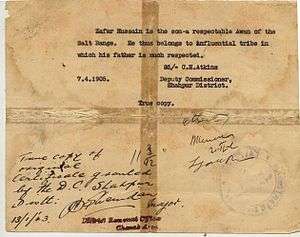Awan (tribe)
| Regions with significant populations | |
|---|---|
| Pakistan | |
| Languages | |
| Punjabi (Saraiki, Hindko), Pashto, Pahari, Urdu | |
| Religion | |
|
|
Awan (Urdu: اعوان), is a tribe living predominantly in northern, central, and western parts of Pakistani Punjab, with significant numbers also residing in Khyber Pakhtunkhwa, Azad Kashmir and to a lesser extent in Sindh and Balochistan.
History

People of the Awan community have a strong presence in the Pakistani Army[1] and have a strong martial tradition.[2] Christophe Jaffrelot says:
The Awan deserve close attention, because of their historical importance and, above all, because they settled in the west, right up to the edge of Baluchi and Pashtun territory. [Tribal] Legend has it that their origins go back to Imam Ali and his second wife, Hanafiya. Historians describe them as valiant warriors and farmers who imposed their supremacy on their close kin the Janjuas in part of the Salt Range, and established large colonies all along the Indus to Sind, and a densely populated centre not far from Lahore.[3]
Whereas Prof Ahmad Hasan Dani claimed that the Awans were, in fact, indigenous to Northern Punjab, and might well be the ancient Abanii mentioned by Greek and Roman travelers and historians.[4]
On a rural level, Awans historically were of the zamindar or landowning class[5] and many Awan families to this day live on and cultivate land, which their ancestors have held for centuries. They often carry titles typical to Punjabis[6] who own tracts of ancestral land.
Notable people

- Air Marshal Nur Khan, Commander in Chief of the Pakistan Air Force, 1965–69, Governor of West Pakistan, 1969–70, and recipient of the Hilal-i-Jurat.[7]
- Amir Mohammad Khan of Kalabagh, Governor of West Pakistan, (1960–66)[8]
- Malik Meraj Khalid, Caretaker Prime Minister of Pakistan, Speaker of the National Assembly, Chief Minister of Punjab][9]
- Major General Ameer Faisal Alavi, First General Officer Commanding of the elite Special Service Group of the Pakistan Army[10]
- Qazi Mian Muhammad Amjad, eminent legal scholar of the Qur'an, Hadith, and the Hanafi school of Islamic law[11]
- Sultan Bahu, Sufi saint, poet and scholar,[12]
See also
References
- ↑ Jones, P.E., 2003, The Pakistan People's Party: Rise To Power, Oxford University Press, p.61.
- ↑ Ali, I., 2003, The Punjab under Imperialism, 1885–1947, Oxford University Press, p.114.
- ↑ Jaffrelot, Christophe (2004). A History of Pakistan and Its Origins (Reprinted ed.). Anthem Press. p. 205. ISBN 978-1-84331-149-2.
- ↑ AH Dani 'Some prominent tribes of Northern Punjab: A Monograph' Peshawar, 1993
- ↑ Ahmed, S., 1977, Class and Power in a Punjabi Village, Monthly Review Press, p.p. 131-132.
- ↑ Ahsan, A., 1996, The Indus Saga and the Making of Pakistan, Oxford University Press, p.88.
- ↑ Khan,R., 1999, The American Papers: Secret and Confidential India-Pakistan-Bangladesh Documents, 1965–1973, Oxford University Press, p.265.
- ↑ Feldman, H., 1972, From Crisis to Crisis: Pakistan 1962–1969, Oxford University Press, p.57.
- ↑ "City: Awan community grieved over Malik's demise. – PPI – Pakistan Press International | HighBeam Research – FREE trial". Highbeam.com. 2003-06-13. Retrieved 2010-12-29.
- ↑ "My soldier brother who died for honour, by Nobel laureate V.S. Naipaul's wife". Daily Mail. London. 31 January 2009.
- ↑ Sarwar, S., 2002, Wadi Soon Sakesar: The Soon Valley, Al-Faisal Nashran, p.35, p.149, p.152, p.163, p.177.
- ↑ https://books.google.com/books?id=e8o5HyC0-FUC&pg=PA187&dq=Sultan+Bahu+Awan&hl=en&sa=X&redir_esc=y#v=onepage&q=Sultan%20Bahu%20Awan&f=false